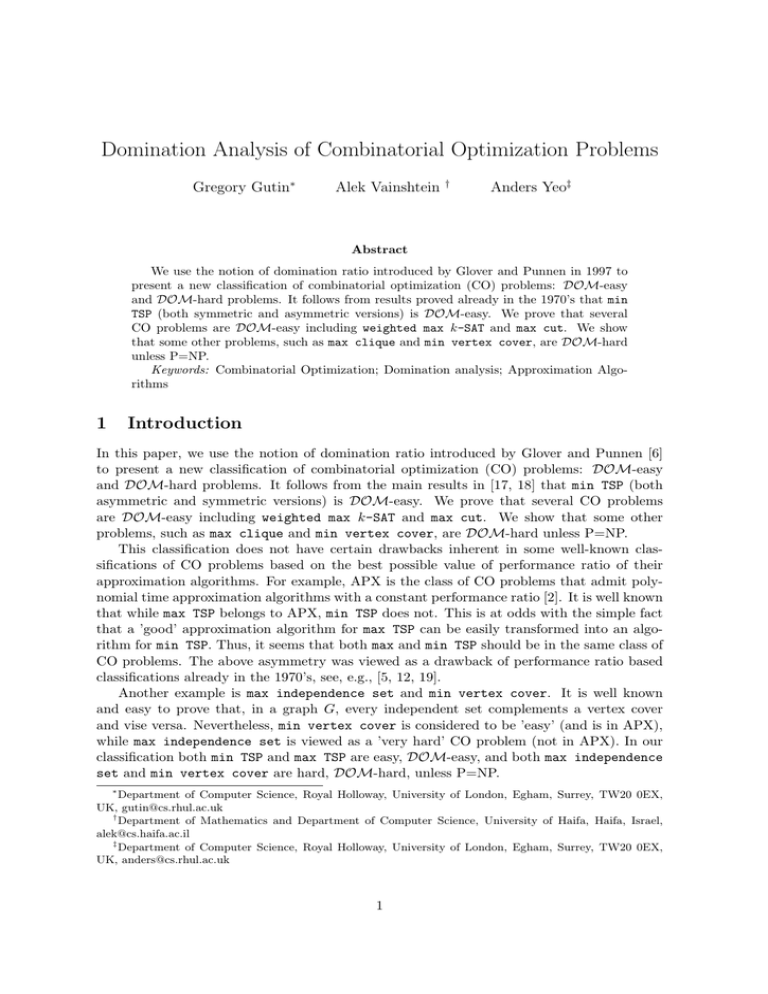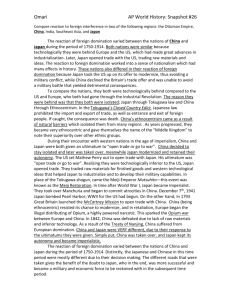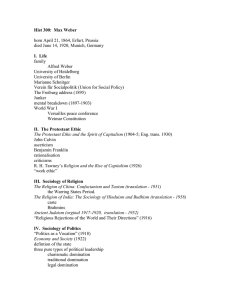Domination Analysis of Combinatorial Optimization Problems Gregory Gutin Alek Vainshtein Anders Yeo
advertisement

Domination Analysis of Combinatorial Optimization Problems
Gregory Gutin∗
Alek Vainshtein
†
Anders Yeo‡
Abstract
We use the notion of domination ratio introduced by Glover and Punnen in 1997 to
present a new classification of combinatorial optimization (CO) problems: DOM-easy
and DOM-hard problems. It follows from results proved already in the 1970’s that min
TSP (both symmetric and asymmetric versions) is DOM-easy. We prove that several
CO problems are DOM-easy including weighted max k-SAT and max cut. We show
that some other problems, such as max clique and min vertex cover, are DOM-hard
unless P=NP.
Keywords: Combinatorial Optimization; Domination analysis; Approximation Algorithms
1
Introduction
In this paper, we use the notion of domination ratio introduced by Glover and Punnen [6]
to present a new classification of combinatorial optimization (CO) problems: DOM-easy
and DOM-hard problems. It follows from the main results in [17, 18] that min TSP (both
asymmetric and symmetric versions) is DOM-easy. We prove that several CO problems
are DOM-easy including weighted max k-SAT and max cut. We show that some other
problems, such as max clique and min vertex cover, are DOM-hard unless P=NP.
This classification does not have certain drawbacks inherent in some well-known classifications of CO problems based on the best possible value of performance ratio of their
approximation algorithms. For example, APX is the class of CO problems that admit polynomial time approximation algorithms with a constant performance ratio [2]. It is well known
that while max TSP belongs to APX, min TSP does not. This is at odds with the simple fact
that a ’good’ approximation algorithm for max TSP can be easily transformed into an algorithm for min TSP. Thus, it seems that both max and min TSP should be in the same class of
CO problems. The above asymmetry was viewed as a drawback of performance ratio based
classifications already in the 1970’s, see, e.g., [5, 12, 19].
Another example is max independence set and min vertex cover. It is well known
and easy to prove that, in a graph G, every independent set complements a vertex cover
and vise versa. Nevertheless, min vertex cover is considered to be ’easy’ (and is in APX),
while max independence set is viewed as a ’very hard’ CO problem (not in APX). In our
classification both min TSP and max TSP are easy, DOM-easy, and both max independence
set and min vertex cover are hard, DOM-hard, unless P=NP.
∗
Department of Computer Science, Royal Holloway, University of London, Egham, Surrey, TW20 0EX,
UK, gutin@cs.rhul.ac.uk
†
Department of Mathematics and Department of Computer Science, University of Haifa, Haifa, Israel,
alek@cs.haifa.ac.il
‡
Department of Computer Science, Royal Holloway, University of London, Egham, Surrey, TW20 0EX,
UK, anders@cs.rhul.ac.uk
1
Zemel [19] was the first to characterize measures of quality of approximate solutions (of
binary integer programming problems) that satisfy a few basic and natural properties: the
measure becomes smaller for better solutions, it equals 0 for optimal solutions and it is the
same for corresponding solutions of equivalent instances. While the performance ratio and
even the relative error (see [2]) do not satisfy the last property, the parameter 1 − r, where r
is the domination ratio, does satisfy all the properties. Thus, our new classification does not
have the drawbacks of some well-known classifications of CO problems based on performance
ratio. (We do not dispute the fact that the performance ratio by itself is a very useful
parameter for many CO heuristics, but no single parameter can cover a complex issue of
quality of heuristics.) For results on another quality measure satisfying Zemel’s properties,
see [11] and references therein.
Notice that previous papers on domination analysis (see, e.g., [3, 4, 6, 7, 8, 9, 13, 15, 16,
17]) have dealt with evaluation and classification of algorithms. In the present paper we, for
the first time, concentrate on domination properties of CO problems themselves.
2
Terminology and Notation
Let P be a CO problem and A be an algorithm for finding an approximate solution of
P. For an instance I of P, the domination number domn(I, A) of A on I is the number
of feasible solutions of I that are not better than the solution x found by A (including x
itself). (In this paper we consider only CO problems that have the property that every
instance has only a finite number of feasible solutions.) For example, consider an instance
T of the Symmetric TSP (STSP) on 5 vertices. Suppose that the weights of tours in T are
4,5,5,6,7,9,9,11,11,12,14,14 (every instance of STSP on 5 vertices has 12 tours) and suppose
that the greedy algorithm computes the tour T of weight 7. Then domn(T , greedy) = 8. In
general, if domn(I, A) = sol(I), where sol(I) is the number of feasible solution of I, then A
computes an optimal solution for I.
The domination number domn(P, n, A) of an algorithm A for a CO problem P is the
minimum domn(I, A) over all instances I of P of size n. It was proved in [8] (see also
[9]) that domn(STSP, n, greedy) = 1. This means that for every n ≥ 2 there is an instance
of STSP for which the greedy algorithm finds the unique worst possible tour. Not every
heuristic for STSP is that bad: already in 1973 Rublineckii [17] (see also [9]) proved that
vertex insertion algorithms for STSP are of domination number at least (n − 2)!/2. Thus,
certain STSP (and Asymmetric TSP) heuristics always produce tours that are at least as
good as Ω((n − 2)!) other tours, see e.g. [7, 9, 15].
When the number of feasible solutions depends not only on the size of the instance of the
CO problem at hand (for example, the number of independent sets of vertices in a graph G
on n vertices depends on the structure of G), the domination ratio of an algorithm A is of
interest: the domination ratio of A for a CO problem P, domr(P, n, A), is the minimum of
domn(I, A)/sol(I), where as above sol(I) is the number of feasible solutions of I, taken over
all instances I of size n. Clearly, exact algorithms are of domination ratio 1.
An algorithm A for a CO problem P is DOM-good if A is of polynomial time complexity
and there exists a polynomial p in size of P such that the domination ratio of A is at
least 1/p(n) for any size n of P. A CO problem P is DOM-easy if it admits a DOMgood algorithm and P is DOM-hard if there is no DOM-good algorithm for P. The above
mentioned vertex insertion algorithms for STSP are of domination ratio Ω(1/(n − 1)) and
thus STSP is DOM-easy.
In this paper, we prove that several CO problems are DOM-easy. Interestingly, max SAT
2
is among them despite the fact that some well-known algorithms for max SAT are of very small
domination ratio [4]. We also show that several other CO problems, such as max clique and
min vertex cover, are DOM-hard unless P=NP.
3
DOM-hard Problems
Consider max clique, the problem to find the cardinality of a maximum clique in a graph.
Håstad [10] proved that, provided P6=NP, max clique is not approximable within n1/2− for
any > 0, where n is the number of vertices in a graph. We will use this remarkably strong
result to prove the following:
Theorem 3.1 max clique is DOM-hard unless P=NP.
Proof: Let G be a graph with n vertices, and let q be the number of vertices in a maximum
clique Q of G. Let A be a polynomial time algorithm and let A find a clique M with m
vertices in G.
Since the clique Q ’dominates’ all 2q of its subcliques and the clique
M ’dominates’ at
n m
n m q
most m 2 cliques in G, the domination ratio r of A is at most m 2 /2 . By the above
non-approximability result of [10], we may assume that mn0.4 ≤ q. Thus,
n m
(en/m)m 2m
(n/m)m (2e)m
m 2
r≤
≤
≤
= 2s ,
2q
2q
2mn0.4
where s = m(log n − log m + 1 + log e − n0.4 ). Clearly, 2s is smaller than 1/p(n) for any
polynomial p(n) when n is sufficiently large.
2
Obvious graph duality properties immediately imply the following:
Corollary 3.2 max independence set and min vertex cover are DOM-hard unless P=NP.
Theorem 3.1 holds for some cases of the following much more general problem: max
induced subgraph with property Π (see Problem GT25 in the compendium of [2]). The
property Π must be hereditary, i.e., every induced subgraph of a graph with property Π
has property Π, and non-trivial, i.e., it is satisfied for infinitely many graphs and false for
infinitely many graphs. Lund and Yannakakis [14] proved that max induced subgraph with
property Π is not approximable within n for some > 0 unless P=NP, if Π is hereditary,
non-trivial and is false for some clique or independent set (e.g., planar, bipartite, trianglefree). This non-approximability result can be used as in the proof of Theorem 3.1.
4
DOM-easy Problems
Recall that min partition is the following problem: given n numbers V = {a1 , aP
2 , . . . , an },
find
a
bipartition
of
the
set
{1,
2,
.
.
.
,
n}
into
sets
X
and
Y
such
that
f
(X,
Y
)
=
|
i∈X ai −
P
i∈Y ai | is minimum. For simplicity we assume, for min partition (and max cut considered
below), that a bipartition (X, Y ) is an ordered pair and (∅, V ) and (V, ∅) are feasible solutions.
Thus, min partition and max cut have 2n feasible solutions each.
Consider the following greedy-type algorithm G for min partition. G sorts the numbers
such that aπ(1) ≥ aπ(2) ≥ · · · ≥ aπ(n) , initiates X = {π(1)}, Y = {π(2)}, and, for each j ≥ 3,
3
P
P
puts π(j) into X if i∈X ai ≤ i∈Y ai , and into Y , otherwise. It is easy to see that any
solution (X, Y ) produced by G satisfies f (X, Y ) ≤ aπ(1) .
Consider any solution
(X 0 , Y 0 ) ofPmin partition for the input {a1 , a2 , . . . , an } − {aπ(1) }.
P
If we add aπ(1) to Y 0 if i∈X 0 ai ≤ i∈Y 0 ai and to X 0 , otherwise, then we obtain a solution
(X 00 , Y 00 ) for the original problem with f (X 00 , Y 00 ) ≥ f (X, Y ). Thus, the domination number
of G is at least 2n−1 and its domination ratio is at least 0.5. We have proved the following:
Proposition 4.1 min partition is DOM-easy.
Recall that max cut is the following problem: given a weighted complete graph G =
(V, E, w) (weights w on the edges), find a bipartition (X, Y ) of V such that the sum of
weights of the edges with one end vertex in X and the other in Y , called the weight of the
cut (X, Y ), is maximum.
Theorem 4.2 max cut is DOM-easy.
Proof: Let G = (V, E, w) be a complete graph with n = |V | vertices and let W be the sum
of the weights of the edges in G. Clearly, the average weight of a cut of G is W = W/2.
Consider the following well-known approximation algorithm C that always produces a
cut of weight at least W . The algorithm C considers the vertices of G in any fixed order
v1 , v2 , . . . , vn , initiates X = {v1 }, Y = {v2 }, and appends vi , i ≥ 3, to X or Y depending on
whether the sum of the weights of edges between v and Y or between v and X is larger. We
will prove that C is DOM-good. To show this, it suffices to prove that the number of cuts
in G of weight at most W (we call them bad cuts) is at least a polynomial part of all cuts.
We call a cut (X, Y ) of G a k-cut if |X| = k. We evaluate the fraction of bad cuts among
√
k-cuts when k ≤ n/2 − 2 n.
For a fixed edge uv of G among nk k-cuts there are 2 n−2
k-cuts that contain uv. Thus,
k−1
n−2
n
the average weight of a k-cut is W k = 2 k−1 W/ k . Let bk be the number of bad k-cuts.
Then, ( nk − bk )W / nk ≤ W k . Hence,
n
n−2
n
4k(n − k)
bk ≥
−4
≥
1−
.
k
k−1
k
n(n − 1)
√
It is easy to verifyPthat 1 − 4k(n − k)/(n(n − 1)) > 1/n for all k ≤ n/2 − 2 n. Hence, G
has more than n1 k≤n/2−2√n nk bad cuts. By the famous DeMoivre-Laplace theorem of
probability theory, it follows that the last sum is at least c2n for some positive constant c.
Thus, G has more than c2n /n bad cuts.
2
Consider weighted max k-SAT: Given a set U = {x1 , . . . , xn } of variables, and a collection
{C1 , . . . , Cm } of disjunctive clauses each with some positive weight wi , find a truth assignment
for U for which the sum of the weights of satisfied clauses is maximum. We assume that the
constant k ≥ 2. For simplicity, in the sequel true (false) will be replaced by the binaries 1
(0).
Berend and Skiena [4] analysed two algorithms for (unweighted) max k-SAT. Both turned
out to be of domination number at most n + 1 (despite the fact that one of the algorithms
is a local search heuristic). This might indicate that weighted max k-SAT is DOM-hard.
Below we prove that weighted max k-SAT is, in fact, DOM-easy.
Assign every variable its value 0 or 1 independently with probability 1/2. Let pi be the
probability that Ci is satisfied. Clearly, if Ci contains a variable and its negation, then pi = 1,
4
otherwise pi = 1−2−ki , where ki is the number of distinct literals in Ci . Thus,
the expectation
P
of the total weight of clauses satisfied by a random assignment is E = m
w
i=1 i pi .
By the construction described in Section 15.2 of [1], there exists a binary matrix A = (aij )
with n columns and r = O(nbk/2c ) rows such that every r×k 0 submatrix of A contains an equal
number of all binary k 0 -vectors (i.e., vectors with k 0 coordinates) for each k 0 ≤ k. This matrix
can be constructed in polynomial time. Consider the truth assignment βj : x1 = aj1 , . . . , xn =
ajn . Let Tj be the total weight of clauses satisfied by βj . Consider a polynomial algorithm S
that computes T1 , . . . , Tr and outputs
β ∗ (A)
for which the total weight of satisfied clauses is
P
Pm
r
∗
r
T (A) = maxj=1 Tj . We have j=1 Tj = i=1 rwi pi = rE. Thus, E ≤ T ∗ (A). Besides, let
T∗ (A) = minrj=1 Tj , and let β∗ (A) be the corresponding assignment. Clearly, T∗ (A) ≤ E.
Consider all subsets of columns of A. For every such subset Q, replace all zeros (ones) by
ones (zeros) in the columns of A. This results in a binary matrix AQ with the same property
as A. Thus, for the worst assignment β∗ (AQ ) the total weight of satisfied clauses is at most
E. This way, we can find 2n worst assignments (with repetitions) for which the total weight
of satisfied clauses is at most E. Moreover, every worst assignment can be picked up at most
r = O(nbk/2c ) times as it may appear only in at most r matrices AQ obtained from A by
the operation described above. Thus, for at least Ω(2n /nbk/2c ) truth assignments the total
weight of satisfied clauses is at most that for β ∗ (A). Hence, the domination number of S is
at least Ω(2n /nbk/2c ).
We have proved the following:
Theorem 4.3 weighted max k-SAT is DOM-easy.
Consider unweighted max SAT (max k-SAT when k is not fixed). This is weighted max
SAT in which the weight of each clause equals 1. We have
Theorem 4.4 unweighted max SAT is DOM-easy.
Proof: The simplest randomized algorithm for unweighted max SAT consists of assigning
every variable true (false) independently with probability 0.5. This algorithm is derandomized (by the method of conditional probabilities) in Section 5.4 of [2], where it isPshown
that the resulting polynomial deterministic algorithm D always satisfies at least E = m
i=1 pi
clauses (we use the notation in the proof of the previous theorem).
We claim that D is of domination ratio at least 1/(m + 1), where, as above, m is the
number of clauses. Clearly, D finds a truth assignment, which satisfies at least A = dEe
clauses. Observe that A ≤ m. Assume that D is of domination ratio less than 1/(m + 1).
Then (1 − 1/(m + 1))(A + 1) < A, which implies A > m, a contradiction.
2
5
Further Research
In this paper, we determined that some CO problems are DOM-easy, others are DOM-hard
provided P6=NP. For many CO problems, it seems to be a quite non-trivial task to find out
which of the two classes they belong to. One such example, is the quadratic assignment
problem, a generalization of min TSP, which seems to be a good candidate into the class of
DOM-easy problems according to some results in [7]. Nevertheless, we do not know whether
this or some other problems including weighted max SAT are DOM-easy or not.
An interesting problem to investigate is the capacitated vehicle routing problem, a wellknown generalization of min TSP. Another extension of min TSP is the Generalized TSP
(GTSP): given a weighted complete k-partite digraph D with m vertices in each partite set,
5
find a lightest cycle in D that contains exactly one vertex from each partite set. It is proved
in [3] that there is a polynomial time algorithm for GTSP with domination ratio at least
1/((k − 1)m2 ). Thus, GTSP is DOM-easy.
We have seen that min partition admits a polynomial time algorithm with domination
ratio bounded from below by a constant. It would be interesting to determine what other
DOM-easy problems have this property.
Acknowledgement Part of the work was carried out while the first author was visiting
University of Haifa, Israel in September 2002. He thanks the HIACS Research Center and
the Caesarea Edmond Benjamin de Rothschild Foundation Institute for Interdisciplinary
Applications of Computer Science (Israel) for financial support. He is also grateful to Noga
Alon and Michael Krivelevich for useful discussions of the results of this paper and very
helpful suggestions.
References
[1] N. Alon and J.H. Spencer, The Probabilistic Method, 2nd edition, Wiley, New York, 2000.
[2] G. Ausiello, P. Crescenzi, G. Gambosi, V. Kann, A. Marchetti-Spaccamela and M. Protasi,
Complexity and Approximation, Springer, Berlin, 1999.
[3] D. Ben-Arieh, G. Gutin, M. Penn, A. Yeo and A. Zverovitch, Transformations of Generalized
ATSP into ATSP. To appear in Oper. Res. Letters.
[4] D. Berend and S.S. Skiena, Combinatorial dominance guarantees for heuristic algorithms.
Manuscript, 2002.
[5] G. Cornuejols, M.L. Fisher and G.L. Nemhauser, Location of bank accounts to optimize float;
an analytic study of exact and approximate algorithms. Management Sci. 23 (1977) 789–810.
[6] F. Glover and A. Punnen, The traveling salesman problem: New solvable cases and linkages with
the development of approximation algorithms, J. Oper. Res. Soc. 48 (1997) 502–510.
[7] G. Gutin and A. Yeo, Polynomial approximation algorithms for the TSP and the QAP with a
factorial domination number. Discrete Appl. Math. 119 (2002) 107–116.
[8] G. Gutin, A. Yeo and A. Zverovitch, Traveling salesman should not be greedy: domination
analysis of greedy-type heuristics for the TSP. Discrete Appl. Math. 117 (2002) 81–86.
[9] G. Gutin, A. Yeo and A. Zverovitch, Exponential Neighborhoods and Domination Analysis for
the TSP. In The Traveling Salesman Problem and its Variations (G. Gutin and A.P. Punnen,
eds.), Kluwer, Dordrecht, 2002.
[10] J. Håstad, Clique is hard to approximate within n1− , Acta Mathematica 182 (1999) 105–142.
[11] R. Hassin and S. Khuller, z-Approximations. J. Algorithms 41 (2001) 429–442.
[12] H. Kise, T. Ibaraki and H. Mine, Performance analysis of six approximation algorithms for the
one-machine maximum lateness scheduling problem with ready times. J. Oper. Res. Soc. Japan
22 (1979) 205–223.
[13] A.E. Koller and S.D. Noble, Domination analysis of greedy heuristics for the frequency assignment
problem. Submitted.
[14] C. Lund and M. Yannakakis, The approximation of maximum subgraph problems. Proc. 20th
Int. Colloq. on Automata, Languages and Programming, Lect. Notes Comput. Sci. 700 (1993)
Springer, Berlin, 40–51.
6
[15] A.P. Punnen, F. Margot and S.N. Kabadi, TSP heuristics: domination analysis and complexity.
To appear in Algorithmica.
[16] A.P. Punnen and S. Kabadi, Domination analysis of some heuristics for the asymmetric traveling
salesman problem, Discrete Appl. Math. 119 (2002) 117–128.
[17] V.I. Rublineckii, Estimates of the accuracy of procedures in the traveling selesman problem.
Numerical Mathematics and Computer Technology, no. 4 (1973) 18–23. (in Russian)
[18] V.I. Sarvanov, On the minimization of a linear from on a set of all n-elements cycles. Vestsi
Akad. Navuk BSSR, Ser. Fiz.-Mat. Navuk no. 4 (1976) 17–21 (in Russian).
[19] E. Zemel, Measuring the quality of approximate solutions to zero-one programming problems.
Math. Oper. Res. 6 (1981) 319–332.
7




